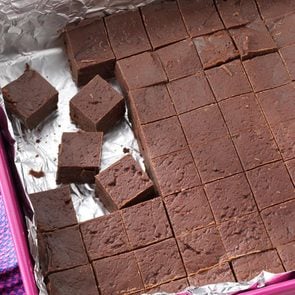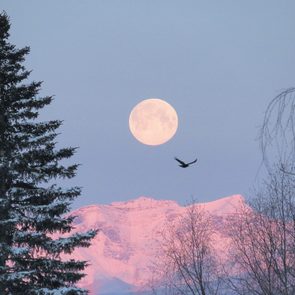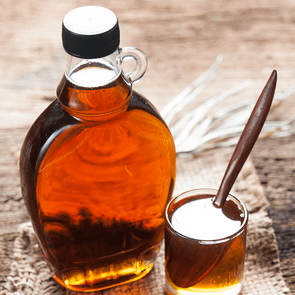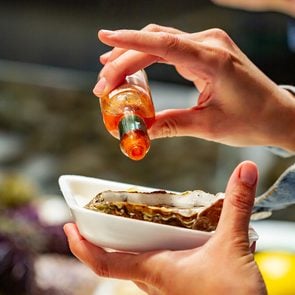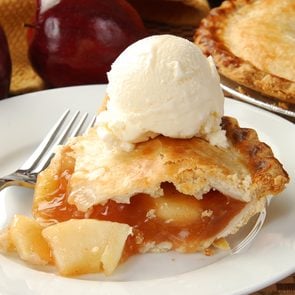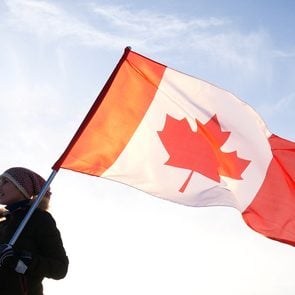Refrigerated leftovers typically last up to four days if your leftovers are sealed and stored correctly. For most people, covering a plate with foil and tossing it in the fridge is a quick, easy way to store food. However, wrapping your food in a sheet of aluminum foil is also an easy way to put yourself at risk for health hazards.
Much like we need air to breathe, bacteria need air to thrive. Some bacteria like staph and Bacillus cereus, which causes foodborne illnesses, produce toxins that aren’t destroyed by high cooking temperatures. When a hot meal is left out at room temperature for more than two hours, the bacteria grow rapidly, according to the Washington State Department of Health.
Using aluminum foil to cover food poses the same risk, since it doesn’t completely seal your food off from the air. “When air is present, that allows the bacteria to grow faster, so you really want to get the right containers and pack things appropriately,” says Lindsay Malone, a registered dietitian. “Otherwise, your food isn’t going to last.”
Malone’s golden rule for packing leftovers is to always seal them in shallow, air-tight containers to speed up the cooling process and keep bacteria off of your food. And make sure you put the food away in the fridge within two hours before the bacteria has time to wreak havoc on the home-cooked meal that you spent hours preparing and cooking. Dairy and meat products are especially prone to bacteria growth, which reiterates just how important it is to use air-tight containers for any and all leftovers. Also, make sure to throw away any food that has been sitting out longer that. (Here are more tips on how to prevent food poisoning.)
“If you have an abundance of food left over, the smartest thing to do would be to put a portion of it in the refrigerator, and then pack a portion of it really nice in air-tight containers, and put it into the freezer,” says Malone. “And then when you’re ready to eat it, take it out.”
Next, check out the expiration dates you should never ignore.
Few things compare to corn on the cob. For those who want to get their corn fix without waiting for corn to boil in a big pot or putting it on the grill, there’s another clever method.
If you’re wondering how to cook corn on the cob in the microwave, we’ve got you covered. You’ll have juicy, plump corn on the cob ready in just a matter of minutes. Holding onto the ends and diving in to take a big bite is as satisfying as can be!
Is It Better to Microwave or Boil Corn on the Cob?
Each way to cook corn on the cob has its own pros and cons, and comparing microwaving to boiling is no different.
If you’re focused on preparing a main dish that needs most of your attention, you may want to microwave the corn so you can focus on prepping the rest of the meal. Microwaving is also a good bet when you’re crunched for time, or only need 1 or 2 ears of corn. If you ask me, it feels unnecessary to boil a whole pot of water for a single corn cob!
On the other hand, if you’re planning on making more than 4 ears of corn, boiling may be easier because you won’t have to swap plates of corn in and out of the microwave several times. (We recommend only microwaving 4 corn cobs at a time.) Instead, you can heat up 1 or 2 big pots of water and get it all cooked in one swoop. Of course, that means you have to wait for the water to boil first, and husk the corn as well—but it’s easy to husk while you’re waiting for the water to heat up.
No matter how you choose to do it, by following our methods you’ll end up with perfect corn on the cob every time.

How to Cook Corn on the Cob in the Microwave with the Husk
The beauty of corn on the cob is that it’s in its own self-contained vessel, and that comes in handy for cooking. Instead of shucking the corn ahead of time, go ahead and leave it on. This will help the corn retain moisture while it cooks.
Directions
Step 1: Cook in the microwave
Place the ear of corn in the microwave and cook on high for 3 minutes. Add an additional 30 seconds if the corn needs more cooking time.
Step 2: Let cool and shuck
Once your corn has cooked, set the ears aside to cool. Once cooled, shuck the corn before diving in.

How to Cook Corn on the Cob in the Microwave Without the Husk
If you prefer to shuck your corn when you get home from the store or right before cooking—or, you’re buying pre-shucked corn—you can still cook it in the microwave.
Directions
Step 1: Prep the corn
Wet a paper towel and wring it out. Wrap the ear in the damp paper towel (to mimic the husk) before placing it in the microwave. Repeat this step with all ears, as this will help retain plenty of moisture while cooking.
Step 2: Cook in the microwave
Microwave the corn on high for 3 minutes. Cook for 30 seconds more if it needs additional cooking time. Once the corn is cooked, it’s ready to be buttered and sprinkled with your favourite seasonings!
How Do You Cook Multiple Corn Cobs in the Microwave?
You can cook up to 4 corn cobs in the microwave at a time. If you’re cooking corn on the cob in the husk, increase the microwave time to 4 minutes (instead of 3), and if you’re cooking corn on the cob without the husk, microwave for 6 (instead of 3). If they’re still not done after 6 minutes, continue to microwave the corn in 30-second increments until it’s just right.
How to Store Cooked Corn on the Cob
Corn on the cob is best eaten right after cooking, so try your best to only cook what you and your family (or guests) will eat in one sitting. If you do have leftovers, you can store the ears of corn in an airtight container for up to 3 days.
How to Reheat Corn on the Cob
When you’re craving corn on the cob again, you can reheat it in the microwave by wrapping it in a damp paper towel like you may have done the first time. If you need to cut the corn off the cob for another recipe, we’ve got the perfect sweet corn hack for you:
Pull out a Bundt pan and carefully stand up the ear of corn in the centre, holding it with your non-dominant hand at the top. Take your knife and start cutting off rows of cooked corn. The kernels will fall right into the Bundt pan! Note: One ear of corn will equal about 2/3 of a cup.
Discover more cooking hacks that’ll save you time (and money!) in the kitchen.

Chasing the Northern Lights in Canada
For an ever-growing community of northern-latitude-based night skywatchers in Alberta and across Canada, a trifecta of clear skies, active solar activity and a southern tip to our magnetosphere can only mean that when it comes to seeing the northern lights—it’s game on!
Alberta Aurora Chasers (or AAC), a social media-based group, began as a small group of night sky enthusiasts, and has swelled considerably. These members have one common goal—to see the aurora borealis. Chris Ratzlaff, Alberta Aurora Chaser’s group administrator, reflected recently on the explosive popularity of chasing the northern lights in Canada, and the phenomenal STEVE (sub auroral arcs). “The Alberta Aurora Chaser community started as a small group of experienced aurora hunters in 2012, helping one another improve our ability to see the aurora within Alberta, an area at a latitude with only sporadic aurora activity… In 2015, our community started to focus on helping others in Alberta learn how to determine when they might be able to catch the sporadic auroral displays that grace our skies. Ever since then, our community has been increasing by at least 50 percent per year, to over 26,000 members currently, with members across Canada and around the world (though, we’re still largely Albertan in composition).”

Attracting NASA’s Attention
An exciting partnering of citizen science and scientists from the University of Calgary and NASA have drawn significant international attention to the beautiful arc STEVE that can appear with a northern light show. A recent Canadian documentary, Chasing Steve, profiles several of these Alberta-based chasers and how, through photographs and discussion, they managed to get the attention of the scientific community internationally, including NASA. A program called Aurorasaurus has been developed through NASA Goddard scientist Liz MacDonald’s efforts, allowing ordinary Canadians on the ground to report their aurora sightings, furthering research in the process. This truly unique collaboration between citizens and the worldwide scientific community has demonstrated how a love of nature and exploring our province at night can bring about and drive new discoveries in science! In 2019, several aurora-chasing Albertans were recipients of a very special award from NASA for bringing attention to STEVE (Strong Thermal Emission Velocity Enhancement).

Anything Can Happen
A nightly thread of chatter on social media is started in AAC when solar conditions look favourable, and the excitement among the many members is palpable. Everyone wants to know the best place to go, what kind of camera to take, and when it is poised to “happen.” People are excited to take their children, family members and out-of-town visitors to the best spots in the hope of catching a celestial show. Dozens of members weigh in, posting photos, comparing sightings, and sharing the thrill when the beautiful pillars of light begin to dance in Canada’s northern skies. Since the aurora rotates around Earth from the northeast, comments pour in from across the country, informed skywatchers reporting bands of light in northern Manitoba and Saskatchewan, alerting the Albertans and British Columbia night sky enthusiasts that a show is imminent. It’s important to note: this is nature and not a scheduled movie—anything can happen anytime, and there is never a guarantee even when conditions are all aligned!
Explore more awe-inspiring natural wonders of Canada.

Everyone is Welcome
Members span from the northern areas of Atlantic Canada all the way to northern B.C., everyone in their little corner of the country hoping to see the magical display. Take a drive north of Calgary on such an active evening, and you will inevitably spot random vehicles pulled over, small groups of photographers with tripods out at some favourite spots. There are even recommendations of best viewing locales in the group itself, and members are always hospitable to those totally new to the northern lights experience. You don’t need a fancy camera or a scientific background to participate or learn—it’s simply a matter of following the discussions, jumping in the car and heading to dark skies away from the city lights. Of course, aurora chasing is far less “chase” and more waiting, so patience is essential. For some, having a whole host of gear to photograph these lights is the ultimate goal, including a tripod, remote shutter and a wide lens with a low F-stop. But Albertans also constantly post photos taken with cell phones or point-and-shoot cameras; it is a show of nature open to anyone at any skill or interest level. There is a certain bond felt among people watching this display at night, knowing that all over Canada, others are sharing the same magical nighttime experience.
Check out more northern lights pictures that’ll take your breath away.

Helpful Hints
On one of my more legendary aurora gatherings on New Year’s Eve, friends visiting from France showed up with mulled cider and fois gras, sitting in lawn chairs and standing in awe, frigidly admiring the beautiful green and purple bands dance and undulate across the Prairie skies. Thanks to all of today’s apps and technology, it is possible to know minute by minute when activity might be expected, even with only a very basic understanding of the science behind the aurora borealis. It is essential to dress for chillier conditions even in summer, as hands and camera gear can get cold quickly. In summer, blankets, and even a coffee or hot chocolate, give the celestial show a sense of occasion, Canadian-style!
Don’t miss this gorgeous gallery of prairie grain elevators.

A Strong and Supportive Community
There is a wonderful by-product of witnessing these dancing pillars in a sky full of stars and that is the gift of perspective. The night sky has a healing way of putting all of the world’s turmoil and problems in perspective, as you stand under a billion stars and listen to the peaceful sounds of the night. Through this shared passion, it has also created a very strong and supportive community of nature-loving astro fans. It’s not unheard of to read of someone stuck in a snowbank or have a flat tire on a country road, only to have four or five other night skywatchers in the area show up to good-heartedly pull them out or offer assistance. If the aurora doesn’t come out to play, the photos are instead that of space station fly-bys, meteors caught on camera or Milky Way and starscapes.
The night skies have truly drawn Canadians together. A huge pool of beautiful photos, videos and friendships have been created in this vibrant community. Other groups in Saskatchewan, Manitoba and Ontario as well as Atlantic Canada, and as far as the United States and Tanzania have allowed Canadians to collaborate and share their learning, questions and experiences with a huge group of nature-lovers and photographers internationally. The best part is, when it comes to the northern lights in Canada, it is never the same show twice!
Inspired to seek out the northern lights in Canada? Find out the best places to catch the aurora borealis across the country.
You can tell a lot from the design and colour of food packaging. The colour of a packet of M&Ms, for example, can tell you whether they’re peanut, regular, crispy, or caramel, while a yellow cap on a Coca-Cola bottle means something else entirely. And if you’ve ever glanced at the back of a food package, you know they’re chock full of information: the story of the brand, nutrition facts labels, ingredients both familiar and not, and something called a “serving size,” which I have personally never adhered to. But there’s something else printed on the back of most food packaging: several brightly-coloured circles or squares that look like some sort of secret language. However, these shapes aren’t an indication of flavours, vitamins, or minerals. They’re really not there for us consumers at all, but rather, for the printing engineers.
What do coloured circles on food packages mean?
The coloured circles on food packages can come in a variety of colours: pink, yellow, blue, black, orange, purple, or green, in varying shades of light and dark. Apparently, those coloured shapes are called “printer’s colour blocks” or “process control patches,” and they’re there to help the printing team who prints the food packaging. We consulted an expert printing engineer, Meg Schiraldi, to find out exactly what that means.
“When the packaging is printed, technicians use the coloured circles to check that the printing ink is the correct [colour] and quality. They compare the colour to boxes printed around the world to ensure consistent brand colours,” Schiraldi explained. “Most printers only use four colours: cyan (blue-green), yellow, magenta, and black. But some printers have extra colours like orange, green, and violet. This helps them match challenging colours like Home Depot orange and FedEx purple. That’s why you may see more circles printed on some packages—they need to check each colour of ink!”
So there you have it! Coloured circles on food packages help printers to colour match when they’re printing food packaging and retain brand consistency all over the world. That means you can reach for a yellow packet of M&Ms in Shanghai, Sarajevo, or Sydney and know you’ll be getting peanuts. Peanut M&Ms, that is. Thanks, coloured circles! Without you, not all food packages would come out the same, and it sure is nice to be able to rely on at least one thing in this world.
Next, find out the real reason suit jacket pockets are sewn shut.

Hotels are nice and tents are neat, but there’s something special about an RV. It blends the best parts of multiple types of travel—the comfort of your bed at home, the gorgeous scenery of a road trip and the nights around a campfire of tent camping. With an RV, you can explore the best parts of Canada, with no suitcases required. But if you’re new to RVing and feel a bit intimidated, these tips can help you take the road like a pro.
#1. Test drive your RV by renting first.
RV stands for “recreational vehicle” and travel trailers, motorhomes and park models of all different sizes fit under that umbrella. (This breakdown of models can help you compare!) Before you buy, consider renting one or two styles and see if you fall in love.
#2. Book your RV parks or campgrounds in advance.
Planning your route ahead of time and booking your accommodations accordingly, will save you the most money and allow you to pick the spots that have the amenities you want (think RV hookups, pools, playgrounds or fire pits).

#3. Choose sites that have an RV hookup.
Life will feel a whole lot easier with a campsite that provides full RV hookups with access to power and running water. If you’re new to RVing and feeling intimidated by the thought of RV hookups, rest assured it’s simpler than it seems. When you rent an RV, you’ll receive a tutorial specific to your model that will show you the ropes.
#4. Arrive before dark.
If you’re just learning how to set up your RV, avoid doing it in the dark. It could mean you drive less each day than you might prefer, but it will alleviate stress in the long run.

#5. Plan and prep some meals ahead of time.
One of the perks of RV travel is you have a fridge and freezer with you everywhere you go. To cut down on food prep time when you’re on the road, cook up some freezer meals (think chili, beef pot pie and breakfast burritos) in advance. It also eliminates the need to purchase all your meals on the road, saving you time, and more importantly, money!
#6. Make a plan for getting online.
Before you head out on the road, decide if you want to use WiFi (often free at some campgrounds and spaces like cafes and libraries), mobile data or a satellite. Satellites tend to get the best coverage, but they’re also the most expensive. Click here for more internet access tips.

#7. Pack as light as possible.
Where you go, your stuff goes too, which is a great perk of RVing. But the heavier the load, the more you’ll pay in gas. Follow this packing list so you have the necessities but don’t overpack.
#8. Buy gas off the main roads.
Typically, gas on busy highways will be more expensive than less-frequented pit stops. Try to plan your route so you can fill your tank off the main roads. You might also want to bring along one or two gas canisters that you can fill up when you find a good deal.
#9. Learn to level your RV.
Properly levelling your RV will help to keep it in good working order. This video can help you learn how to level your vehicle.

#10. Take time to look around you.
Remember: RV travel is an adventure and you’re making memories to last your whole life. Try not to worry too much about WiFi access or following your schedule to an absolute T. Instead, live in the moment, keep your eyes open to your surroundings and say yes to opportunities when they arise.
For more useful tips for renting or buying an RV, planning a route and more, visit GoRVing.ca—a free resource for newbies and pros alike.

These Lost Villages Are Quite Literally Hidden Gems in Ontario
Long Sault Parkway, a scenic ribbon of highway between Kingston and Montreal, connects an archipelago of 11 picturesque islands, each with their own beaches, parkland and campgrounds. These islands are all that’s left of the Lost Villages of the St. Lawrence, a handful of Ontario hamlets that were cleared and flooded to create a dam and man-made lake during the construction of the St. Lawrence Seaway in the 1950s. When the days are clear and the water level is low, some of the villages’ remnants—churches, houses, stores—are visible in the water from the shoreline; quite literally, hidden gems in Ontario. Morrisburg, Ontario.
Bust Some Ghosts
The largely abandoned ghost town of Balaclava, accessible just off Highway 41, could pass for the set of Sleepy Hollow. A handful of residents still live there. But they’re outnumbered by eerily antiquated structures, such as an empty blacksmith shop, rickety general store, dam and a 200-year-old sawmill—all best viewed from a safe distance (for both supernatural and structural reasons). Balaclava, Ontario.

Take a Hike
We’re calling it: the Bruce Peninsula Grotto in Georgian Bay is one of the most beautiful hidden gems in Ontario. The magical lagoon looks like something off a Caribbean island, with cerulean waters, rocky outcroppings and an underwater tunnel (for viewing only) that’ll leave you feeling like the Little Mermaid. It’s about a 45-minute hike through the just-as-lovely Bruce Peninsula to get to the grotto. Tobermory, Ontario.
Discover the best beaches across Canada.

Bring Home the Bacon
Emeril Lagasse, Bobby Flay, David Chang and the late Anthony Bourdain are just some of the celebrity gastro-geeks who’ve sampled the peameal bacon sandwich at Carousel Bakery, the most famous stall in Toronto’s St. Lawrence Market. It’s hard to find a better lunch downtown for less than $10: a stack of four fat peameal slices smeared with hot mustard and squished into a puffy white bun. Toronto.
Here are 10 classic Canadian foods everyone needs to try at least once.

3-D Print a Mini-You
Jean-Louis Brenninkmeijer, a Dutch-born Canadaphile, has spent a decade building Little Canada, a gobsmackingly elaborate miniature model of the Great White North. Included at the museum are dollhouse-sized versions of Niagara-on-the-Lake, Mont Sainte-Anne and Ottawa’s Parliament Hill. For a fee, they’ll 3-D print you as a figurine (a process they refer to as “littlization“) that you can place in the mini-destination of your choice. Toronto.
Explore Canada’s most unusual museums.

Ring Bell’s Bell
In 1874, Alexander Graham Bell created the world’s first telephone in his father’s Brantford farmhouse; two years later, he made the first long-distance phone call, between his workshop and Paris, Ontario. Now a museum, the Alexander Graham Bell Homestead has been restored to its Bell-era glory, with original furnishings in the library, dining room, kitchen, bedrooms and carriage house workshop, along with models of Bell’s first telephones. Brantford, Ontario.
Looking for more hidden gems in Ontario? Check out the 10 best day trips from Toronto.
Each and every one of us has a favourite sleeping position—whether it’s the fetal curl, the splaying starfish, the yearner’s stretch, or the log pose. But there’s one sleep habit we all have in common, and that’s our tendency to sleep under a blanket.
Although bedding used to be a luxury reserved for the rich and powerful, such as kings and wealthy merchants, these days sleeping under a blanket is fairly universal. And even if you’re roasting in your airless room, chances are you’ll still get tucked in. What gives?
As always, science saves the day with the answers to our deepest questions. For one, your body’s core temperature drops before and during your slumber, so you need the blanket to stop your shivers.
That nightly cool down does more than simply keep you comfortable while you snooze—it’s actually a key part of what regulates the circadian rhythm that determines when your body is ready to go to sleep and when it’s ready to wake up. And it begins about an hour before you hit the sheets and continues to drop while you sleep, eventually reaching one or two degrees below your average body temperature. But once you reach the rapid eye movement (REM) sleep cycle your body loses its ability to regulate its temperature. Your blanket is there to keep you warm—even on a summer night.
There’s a behavioural element to sleeping with bedding, too. Truth be told, we’ve been conditioned to use blankets since birth.
“A blanket creates a ‘microclimate’ around the skin that is usually warmer than the surrounding environment,” says Michael Grandner, PhD, director of the Sleep and Health Research Program at the University of Arizona in Tucson. “It traps heat that escapes from the body at night, keeping the body warm. And since most people sleep with a blanket, the physical sensation of the blanket itself gets paired with sleep. This means that simply being under a blanket can cause the brain and body to be primed for sleep. It can actually trigger a sleep response.”
Research suggests that weighted blankets may be especially beneficial for people with insomnia and anxiety. A study of otherwise healthy people who suffered from chronic insomnia, published in 2015 in the Journal of Sleep Medicine & Disorders, found that those who slept under a weighted blanket reported having a calmer night’s sleep. And a review of research published in 2020 in the American Journal of Occupational Therapy suggests that people with anxiety may also benefit from sleeping with a weighted blanket.
Why? The blanket made them feel not only safe and secure, but also more comfortable.
“The perfect blanket is one that’s warm enough to keep you comfortable, but breathable enough to not accumulate moisture and sweat,” says Grandner. “It should be soft enough to get out of your way, but substantial enough that you feel it.”
If you decide to try a weighted blanket, keep in mind: The blanket’s actual weight matters. It shouldn’t be too light or heavy, noted the researchers, and the weight must be evenly distributed throughout the fabric.
Weighted or not, adds Grandner, “a soft, comfortable blanket is just relaxing and helps people drift to sleep.”
That’s reason enough to get tucked in tonight.
Next, discover 12 secrets for a good night’s sleep.
Tires may be to blame
One possible cause of shaking when you apply the brakes, especially at high speeds on the highway or when going downhill, is your tires. This is the first thing you should investigate if you experience shaking while braking. Your wheels may be out of alignment, or you may have a bad tire that is unbalanced. (Learn how to extend the life of your tires.)
Your car service provider can check it out and fix the issue easily if there is a problem. This might mean that you have to buy a new tire or two (check your tire warranty if a replacement is needed).
They may suggest a front-end realignment, which is fine, but understand that it will not be a permanent fix. You can do your own alignment work but it requires expensive diagnostic equipment and is not considered a smart DIY task since most garages charge less than $100 for the service.
Brakes could be the culprit
Perhaps the leading cause of shaking when you brake, especially at highway speeds, is in the braking system itself. Most cars today have disc brakes in the front wheels, and often in the rear wheels as well (although economy cars still have drum brakes in the rear wheels). Disc brakes rely on a metal rotor that is coupled to each wheel and spins along with it. Stopping happens when you step on the brake pedal, which causes calipers (a little like the ones on your bicycle) to clamp down on the rotor to slow and then stop it. (Read up on brake calipers—and how to tell if they’re damaged.)
Eventually, friction from your brake pads can cause wear on the rotors, causing them to become uneven. Or, heat buildup from braking, especially on frequent inclines, can cause one of the rotors to warp.* Then, when the brakes are applied, contact between the pad and rotor can be a bit bouncy, causing a shimmy that is felt mostly in the steering wheel. An auto mechanic may be able to adjust, shim or resurface the rotors to compensate for the unevenness, but replacing them is a surer bet, and a relatively easy DIY job for those comfortable under the hood, too. And, some mechanics recommend that you always replace rotors and brake pads at the same time. Rotors can warp from disuse, as well. If a vehicle hasn’t been moved for a long time, the rotors may warp.
Next, find out what these strange car noises really mean.
*Editor’s Note: There are two trains of thought regarding warped rotors, with some mechanics agreeing with the statements made here, and others asserting that uneven patches on the brake pads are the real cause. We have writers in both camps.
At some point we’ve all had a tough Monday, but it looks like Monday could be hard on your heart, too. Research presented in June 2023 at the British Cardiovascular Society conference in Manchester, U.K. reveals that the most severe type of heart attack, known as ST-segment elevation myocardial infarction (STEMI), is most likely to strike on a Monday.
The study, led by cardiologist Dr. Jack Laffan at Belfast Health and Social Care Trust, examined data from over 10,000 patients. What’s the connection? Your weekend habits and the stress of starting a new week might be key factors. Dr. Laffan shared in a news release, “We’ve found a strong correlation between the start of the working week and the incidence of STEMI. This has been described before but remains a curiosity.”
For more wellness updates, sign up for the (free!) Reader’s Digest Health Report.
What is a STEMI?
Before we proceed, let’s define the term STEMI. The Cleveland Clinic, which is one of the leading heart care hospitals in the United States, explains that a STEMI represents one of the most severe forms of heart attack. A STEMI is the outcome of a blockade of blood supply, which consequently inflicts considerable damage to a broad section of the heart muscle.
What sets a STEMI apart is its unique signature on an electrocardiogram—an ECG or EKG. This diagnostic tool detects and records the electrical activity of the heart. In a STEMI event, the EKG reveals a distinctive pattern, signaling that a primary coronary artery—a significant pipeline supplying blood to the heart—is completely obstructed.
This unusual EKG pattern serves as a red flag for healthcare providers, highlighting the critical nature of the situation. Prompt recognition of a STEMI, followed by immediate medical intervention, can drastically enhance survival rates, mitigate the extent of heart damage, and improve the prognosis for long-term heart health.
Tune in to your body clock
Dr. Laffan proposes that the study results aren’t attributed to a single factor. He asserts: “The cause is likely multifactorial, however, based on what we know from previous studies, it is reasonable to presume a circadian element.”
Your body has a natural rhythm, the circadian rhythm, that guides your sleep and wake cycles. This internal clock also plays a vital role in heart health. Dr. Laffan suggests that the spike in heart attacks on Mondays could be linked to disruptions in the body’s sleep cycle over the weekend.
So, how can you keep your ticker ticking smoothly? Start by setting a consistent sleep schedule, even on weekends, and create a calming bedtime routine to let your body know it’s time to wind down.
Here’s expert advice on how to fix your sleep schedule.
Be mindful of weekend indulgences
Maybe you’re disciplined with nutrition during the week but consider the weekend safe to “cheat.” No judgment: Weekends are a time to let loose, but going overboard might have consequences for your heart. Here’s a sobering fact to consider: A 2015 Harvard T.H. Chan School of Public Health study suggests that binge drinkers are 72% more likely to experience a heart attack than their non-binge-drinking counterparts.
It’s all about balance. Choose to savour your treats mindfully and alternate alcoholic drinks with water. Be sure to incorporate heart-healthy foods and engage in physical activity to keep your heart in tip-top shape.
Find out what booze really does to your body.
Say goodbye to Sunday stress
Maybe you’ve heard of the Sunday scaries, and they can have a real effect—the “anticipatory anxiety” of the upcoming work week can sometimes cast a shadow over your relaxing Sunday. Dr. Joel K. Kahn, MD, an integrative cardiologist, shared in an article with Insider that worries about the week ahead cause adrenaline and cortisol levels to spike. This sudden increase might not only elevate blood pressure, but also enhance clotting—neither of which are beneficial for your heart.
How about turning your Sunday into a day of relaxation and preparation? Engage in stress-reducing activities like yoga, meditation, church or other spiritual practice, or a leisurely walk in the park. Plan your Monday morning to avoid the rush, and create a heart-friendlier start to your week.
Daily love for your heart should be non-negotiable. As scientists work to understand the Monday heart attack spike, you can adopt proactive measures to protect your heart.
Next, find out how it’s actually possible to reverse heart disease.
Within its fragile pastry shell and its sticky filling of butter, sugar, syrup and egg, the butter tart holds Canada’s memories of long weekends, country bakeries, recipes handed down through generations—and an eternal debate over raisins.
Though it is made from pantry staples, the alchemy of a butter tart’s ingredients makes for something all its own. And its simplicity means you’ll usually have what you need on hand to whip up a dozen. Plus, they freeze well (some say they taste even better frozen, especially on a hot summer day).
But why do butter tarts and Canada seem so inseparable?
For me, it’s the memory of eating oozing tarts on a cottage deck in the midday sun, followed by a dive into the lake to wash off all the sticky residue. Often, it was too hot to bake our own, so my family and I would drive into town and wait in line for butter tarts at the local café, sometimes sharing one on the car ride home.
Whatever your own experience, the butter tart is firmly tied to our Canadian identity. People become lifelong devotees to the tart, pledging undying loyalty to their local bakery or their mother’s version.
Here’s the surprisingly controversial story of this sweet little treat.
Controversy #1: The Butter Tarts Origin Story
The exact origin of butter tarts is unknown. Some credit the filles du roi: the young French women who settled in New France between 1663 and 1673 to marry voyageurs. They combined their knowledge of pastry with the ingredients on hand and, according to the Canadian Encyclopedia, created butter tarts.
Others look to settlers from the “border counties” between Scotland and England, who arrived in Canada in the 1800s toting Ecclefechan tarts, also called border tarts. Food writer Elizabeth Baird believes the treat, filled with dried fruit and made in a pie tin, evolved into the butter tart. Further proof? Immigrants from the same region also settled in Georgia, home to pecan pie.
However, culinary historian Liz Driver, author of Culinary Landmarks: A Bibliography of Canadian Cookbooks, 1825–1949, suggests that perhaps homemakers who had dairy, eggs, flour, lard and brown sugar put them together into a humble tart to feed farmhands, family and visitors year-round. This, she says, explains the butter tart’s similarities to Quebec’s sugar pie (which contains whipping cream); the butter tart is a parallel invention born of necessity and similar circumstances. “Why is it,” she asks, “that Canadians can’t just accept that we made something ourselves?”
Controversy #2: National Dessert Status
Does the butter tart deserve icon status in our broad and diverse country? If nostalgia and history are reason enough, then the answer is yes. In 2019, Canada Post even put the butter tart on a limited-edition stamp. (It did not, sadly, taste like a butter tart.)
If that’s not enough, then also consider age and geographic supremacy: butter tarts date to at least the early 1900s and are popular from Newfoundland to British Columbia. But what about Nanaimo bars, a latecomer to the handheld dessert scene, having originated in the 1950s? Well, a 2018 voting bracket created by Daybreak North, a CBC radio show in B.C., still crowned butter tarts the champion holiday treat over Nanaimo bars.
Okay, so they’re nationally revered, but are they a Canadian icon? South of the border, Americans have largely remained unaware of our beloved tart—their loss. In classic Canuck fashion, many Canadians find it more reason to propel the tart to icon status.
Controversy #3: Tours, Trails and Tension
Across the country, tens of thousands of Canadians have taken part in festivals and tours that celebrate the not-so-humble butter tart. It seems every small bakery, especially in rural Ontario, sells them—some displaying ribbons and awards from taste-offs and festivals. The largest festival is Ontario’s Best Butter Tart Festival, which has been running since 2013 in Midland. (In its inaugural year, the festival sold out of 10,000 tarts by 11 a.m.) Around 65,000 people come for one butter tart-filled day in June every year.
In 2006, bakeries and businesses in Wellington County, Ontario, launched Canada’s first self-guided butter tart tourist trail. In 2011, the Kawarthas Northumberland tourism board started a butter tart tour of more than 50 stops through the Kawartha Lakes district, Northumberland County, and Peterborough, Ontario. The Wellington trail team was not pleased and sent a cease-and-desist letter to the new tour. Things calmed down after the two sides met over butter tarts (yes, really) and decided to co-exist.
Controversy #4: The Perfect Butter Tart
Raisins or no raisins? Our passion over the addition of dried fruit has become an ongoing conversation among Canadians. Perhaps it’s what keeps our country together: we love to bicker over something so small and so sweet.
Nuts vs. no nuts: While some (including me) feel that walnuts or pecans take the tart into pie territory, others prefer a little crunch.
Other add-ins: Formerly restricted to raisins, currants and nuts, fillings have started to reflect our country’s diverse cuisines. For creative bakers the tarts are a canvas to experiment with flavours such as cardamom, Nutella, ginger and miso. Some tarts definitely push the classic recipe—there are versions filled with cheesecake or that taste like poutine. Bacon is becoming a popular add-in and bolsters the case for eating butter tarts at breakfast.
Runny or firm? Do you like them so gooey that you’ll need a swim after, or firm enough to eat one-handed while doing chores? Until you find your favourite, maybe you’ll just have to keep testing them all.
© 2020, Emma Waverman. From “The Surprisingly Controversial Story of the Butter Tart,” Cottage Life. (July 6, 2020).
Now that you know the butter tarts origin story, check out 10 must-try Canadian dishes (and the best places in the country to find them).




